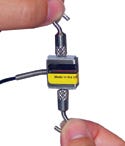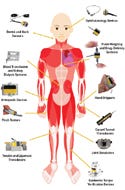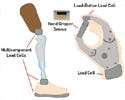Advances in Load Cell Technology for Medical Applications
Originally Published MDDI August 2006 SENSORSMiniaturization and automation are paving the way for new uses for load cells in medical devices.
August 1, 2006
SENSORS
|
An S-beam load cell sensor is used for various medical applications, such as on a blood transfusion bag. |
Load cells are essentially transducers that convert force or weight into an electrical signal. They have been widely used for measuring and sensing applications in virtually every industry for decades. At the heart of most load cells is a strain gauge. This element changes resistance when pulled or pushed (placed under tension or compression). Foil strain gauges are the most common and are created from an ultrathin heat-treated metallic foil, which is either chemically etched on a thin dielectric layer or attached using vacuum deposition or sputtering techniques to bond the materials molecularly. The latter technique is commonly known as thin film. Desirable strain gauges are small in size, low in cost, very sensitive to strain in the load direction, and insensitive to surrounding environment temperature changes.
To measure strain with a strain gauge, an electric circuit is used that is capable of measuring extremely low resistance changes from induced microstrain. Strain gauge transducers typically employ four strain gauge elements that are electrically connected to form a Wheatstone bridge circuit. The optimal choice for strain measurement, a Wheatstone bridge circuit is a four-leg parallel divided bridge circuit that measures electrical changes resulting from resistance changes. Its output voltage is expressed in millivolts per volt of input (mV/V). A Wheatstone bridge is also well suited for temperature compensation.
Types of Load Cells and Corresponding Technologies
The normal configuration for a Wheatstone bridge circuit comprises four strain gauges. But some load cells use 8, 16, 32, or more gauges, while other devices only use one or two. The precise positioning of the gauges, the mounting, and the materials used define the performance of any load cell. The analog output of the transducer is normally signal conditioned, amplified, and digitized to display the force, load, pressure, displacement, or applied torque.
Foil strain gauges have distinct advantages, including reduced size, a variety of gauge patterns, and temperature compensation. Low production cost and flexibility for installation on surfaces that are flat, curved, or slotted, or that are inside holes, also support creative design requirements. For this reason, foil strain gauges are the most common type in use today.
The latest emerging technology is microelectromechanical systems (MEMS). MEMS are microsized silicon structures etched in the forms of beams, diaphragms, or plates that can function as sensors within a load cell. MEMS are fabricated using bulk and surface micromachining, just like any integrated circuit manufacturing process. They can be mass produced, because thousands of sensor elements can be fabricated on a single wafer with integrated supporting circuits. Although millions of sensors can be mass produced at a very low price (as low as a few dollars), their applications are still limited compared with foil strain gauges. The most popular MEMS applications in the medical industry are in the area of low-cost, disposable products that are manufactured in lots of millions. These include disposable blood pressure sensors and angioplasty devices used to measure pressure in balloon catheters.
Moving from Industrial to Medical
In most cases, size and cost are the foremost issues when making the transition from standard industrial to medical applications. The basic technology does not change in terms of such capabilities as range and reliability. Medical applications typically require measurement of loads in ounces, grams, and milligrams, whereas in industrial settings, the load is typically in pounds, kilonewtons, or tons. The only exception to this rule is in physical rehabilitation devices, where standard-sized load cells are used.
All medical load cells must be highly precise and packaged to be portable and lightweight, particularly when they need to be attached directly to patients. If the cell is used inside a machine integrated with another medical device for monitoring, standard packaging materials such as stainless steel and anodized aluminum are used. If it is in contact with the human body or with fluids, special autoclavable stainless-steel or disposable sensors can be used.
Early medical load cell applications included mechanical measurements such as bed-weight monitoring. Until the early 1980s, nurses had to physically monitor patients to track critical weight fluctuations. By affixing load cells to hospital beds, the beds could effectively transmit accurate patient weight to a handheld instrument. Typically four load cells, one under each leg of the bed, fed data to a junction box that was connected to a related instrument or controller.
Small load cells were soon integrated into another area that was susceptible to human error: the infusion pump for administering drugs. Originally, a hanging bag held fluid, medication, or nutrients that were infused to the patient via gravity through a flexible line. Various clamping methods were used to regulate the flow as precisely as possible. Again, this required continual attendant monitoring to ensure that the solution was being delivered properly, that the bag was properly filled at all times, and that no back bleeding was occurring. Integrating a load cell and monitoring system to the basic infusion-delivery method removed guesswork from the process. The load cell measured the exact weight of the bag and immediately sent a warning to a connected device if the weight of the infusion varied from its prescribed path. Normally a small bending-beam load cell sensor with a 100-g to 1-lb capacity was placed in a cartridge under the flexible tube used to deliver the infusion. The sensor detected the changes in tube weight during the flow and communicated with the electronic controller.
The integration of load cells into previously mechanical methods made feedback to other devices possible. Introducing automation to many medical applications enabled a reduction in human error. Data provided by the load cells were permanently recorded, which also greatly improved tracking of medical processes for liability assurance.
Application Examples
Today, load cells in medical devices range in size from 3–4 in. in diameter for physical therapy applications down to smaller than a dime. Measurement ranges run from milligrams to hundreds of pounds and are not affected by the physical dimensions of load cells. The smallest load cell offers the same range, accuracy, and repeatability of its larger cousins. At some point, however, size does begin to limit the capacity of the sensors, but most medical applications do not require the weight range of a large load cell.
|
Figure 1. (click to enlarge) Many medical applications may use sensor technology. |
Modern computerized automation, wireless interfaces, and the shrinking size and enhanced capabilities of semiconductors and electronic circuit devices have greatly expanded the reach of load cell technology in medical applications. The previously mentioned fluid-delivery methods and bed-weight measurement are still widely used, but both are now much more sophisticated with integral automated monitoring equipment (see Figure 1).
Medical load cells are used in a wide range of delicate fluid-monitoring applications including blood transfusions, kidney dialysis, and blood donation. In such applications, the load cells ensure that the amount of fluids entering, leaving, or being replaced in the body are being started, stopped, or recirculated at the right time and in the proper dosage or ratios. Therefore, doctors and nurses can now monitor far more patients in various applications than in the past when everything was done manually.
Kidney Dialysis. A typical kidney dialysis system may depend on one or several load cells to ensure that the filtration system has perfect balance and timing. The dialysis system must remove contaminated blood, clean it, and recirculate the clean, reoxygenated blood. Any malfunction can be disastrous. Load cells used for this type of system are typically in-line, small, and work by monitoring flow changes by sensing the weight of a hanging bag to ensure the dialysis procedure is performed safely every time.
This process is a noninvasive measurement, since body fluid is not in contact with any part of the sensor. A load cell known as an S-beam Jr. is typically used in a dialyzer. It has a 5–10-lb capacity range with 1000% overload protection and is about the size of a quarter. This load cell is attached to the end of a hanging bag. The bag is connected to the dialysis machine via two flexible tubes. One tube is used for the flow inlet and the other is for discharge. Some systems use several bags and require multiple load cells. Each load cell is connected to a programmable logic controller or computer to monitor the flow by weight measurement. Using the load cell information, the system automatically processes and controls the dialysis procedure while collecting data for further analysis when needed.
Endoscopic Surgery. Endoscopy is a unique area aided by load cell technology. In endoscopic surgery, the pressure of instruments can be highly critical and the incision depth needs to be very precise. Load cells can monitor the force of these instruments against the tissue, thereby greatly improving surgical accuracy.
On the front end, during product development of endoscopic tools, small, button-type load cells about 3/8 in. OD or smaller are used to help in improvement of tool design by minimizing the force required for the tool during piercing and penetration. They cover the range of 50–100 lb. These load cells have helped to reduce required forces from 75 lb in earlier tools to about 25 lb or lower. Reducing the amount of required force means that surgeons exert less force and patients experience less pain.
In the final production of such tools, MEMS sensors in very small package sizes (typically 0.4 mm) are integrated within the tool to help surgeons monitor and control piercing and penetration forces during actual surgery. This protects against excessive force and also collects data that can be used for further analysis when needed.
Rehabilitation. Large load cells (2–4 in.) are used in physical therapy to monitor muscle recovery. They are normally integrated with a hand-gripping device of some type to monitor the rehabilitation progress in those who have an injury, arthritis, or have had strokes.
The same theory is used with tension devices to measure leg pushing and contraction values against a surface. A load cell attached to a gripping or tension device can indicate exact changes in an affected muscle and how much progress is being made after each therapy session. This allows the therapist to customize the types of therapy to the needs of the patient. These load cells vary in size from 1 to 4 in. diameter, with measurement ranges of 50–1000 lb. There are many system configurations designed for this purpose, but all have two things in common: the patient exerts force against some object that is connected to the load cell, and the load cell sends the resulting measurement to a readout device or computer. The computer then converts the signal from analog to digital to produce an accurate, real-time display.
Orthopedics. A unique application in the area of corrective orthopedics is placing a very-low-profile flat-plate or load-button load cell into shoe heels with a connection to a headset radio device. When the wearer is walking correctly with proper balance and posture, the load cell activates the radio device and music plays. If the subject falls into an irregular foot pattern, throwing off the correct balance of the body, the radio device will stop playing, thus training the person to correct improper stance and walking patterns.
Monitoring MRI Movement. To control or monitor patient movement during magnetic resonance imaging (MRI), special hand-grip load cells are used to detect movement and monitor any loss of strength. The results will also indicate if the patient is losing consciousness. Proprietary manufacturing processes and material selection are used to develop special, nonmagnetic load cells that can be used in the MRI environment.
Premature Birth Detection. Load cell sensors are also used to monitor irregular pressure changes during pregnancy to help prevent premature birth defects in high-risk pregnancies. One company created a device that includes a bending-beam load cell to monitor these pressure changes. The device uses a special belt that is attached externally to the abdomen of the pregnant woman. The belt is equipped with a microprocessor control, a load cell, and a modem. When irregular pressures are sensed, the device calls the nursing center via the wireless modem to alert the gynecologist if changes in uterine pressure indicate emergency care is required.
Applications on the Leading Edge
|
Figure 2. (click to enlarge) Sensors used in prosthetic applications measure the force applied by feet, legs, toes, or fingers. |
Micro Load Cells. Load cells are used in various ways in both knee and hip joint replacement, both in R&D and during surgery. Small, customized S-shaped shear-beam load cells are used to measure torsional forces of tendons and ligaments during surgical procedures. Also, customized clip-on soft-tissue load cells accurately measure the forces of the knee extensor mechanism interoperatively. Customized load cells used for R&D during the development of implants, such as for the patella ligament, are also used within the implants to measure the tension of a ligament (see Figure 2).
Load cells used directly in knee implants include an implantable knee simulator that measures patellofemoral force on the patella implant and an implantable simulator for the knee and tibia. This device is designed to interface with trial knee implants and to measure the loads between the tibia and the femur. Assessment of the load balance of the tibiofemoral joint can aid in balancing soft-tissue structures. This results in the precise positioning of implants and greater knee stability.
The miniaturization of load cells has also been instrumental in aiding dental researchers and equipment manufacturers identifying the bite strength of each tooth under various conditions. This has enabled improvement of the materials used in dental work as well as dentures and implants. A small, 50-lb-capacity strain gauge load cell, or a customized denture, which includes a sensor under each tooth, provides information to a readout device or remote data acquisition device. That information allows dental technicians to accurately read the positioning and pressure points of the subject's jaw and teeth to create what is needed for a well-aligned and healthy bite.
Pancake and Multicomponent Load Cells. The manufacturers of artificial joints and robotic limbs have borrowed a technique from standard industrial quality control applications. Multiple pancake-type load cells are used in both hip and knee simulator machines, which allow friction and wear tests of multiple joints simultaneously for endurance testing and determining mean time between failure. Testing durability provides a way to develop better, stronger, and more-flexible devices with a goal of lifetime use with no problems.
Rod-End Load Cells. Prosthetic arms and legs have played a big role in mobilizing the handicapped. However, with the absence of the muscles and nerve systems, many abilities are very limited. Manufacturers are now using special rod-end load cells to monitor and display forces, and work is under way to enable such data to be relayed to a patient's brain, creating a closed-loop process.
The Future
Miniaturization and automation are radically changing the face of medical load cell applications. No area has changed more than surgery, thanks to automation. With the growing sophistication of surgical robots, load cells are the key to opening up this cost-effective alternative to ever more delicate procedures. Giving such robots a sense of touch will make them truly effective. Load cells in a variety of sizes, shapes, and ranges are making these advances possible. It is anticipated that in the future, miniaturized and smarter load cells with interchangeability and communication capabilities will be used to give robots sensing ability equal to, if not superior to, human touch. This technology will expand the reach of surgical procedures while lowering the overall cost, bringing life-saving options to more patients than ever before.
Load cells will also be seen in a range of preventive medical devices. Miniaturized load cell devices are already being used to show people the way to correct bad habits and to prevent injury. This can be as simple as integrating a load cell into a golf bag or strength-training equipment to prevent lifting strain. It can be as complicated as the use of multiple miniaturized load cells in robotic artificial limbs to create toes and fingers that can feel pressure and send that data to the brain so the wearer can respond.
At the rate technology is progressing today, by the next decade the common load cell may be the key to opening new avenues in a range of medical procedures that are only being imagined today.
Javad Mokhbery is the founder and CEO of Futek Advanced Sensor Technology. He can be reached at [email protected].
Copyright ©2006 Medical Device & Diagnostic Industry
About the Author(s)
You May Also Like




.png?width=300&auto=webp&quality=80&disable=upscale)
